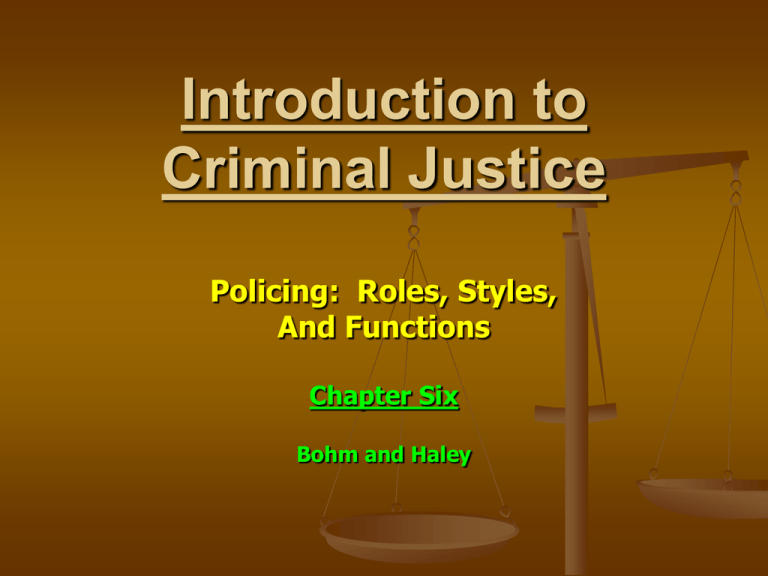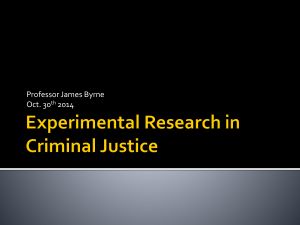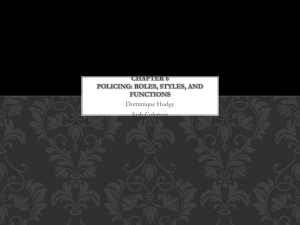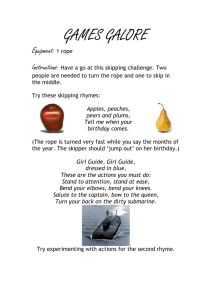Chapter 6
advertisement

Introduction to Criminal Justice Policing: Roles, Styles, And Functions Chapter Six Bohm and Haley Question If a role consists of the rights and responsibilities associated with a particular position in society, Then, “what is your role expectation of a police officer?” Role of the Police Service to the community Public safety Decision-making and discretion Adhere to code of ethics Role Conflict: Stress from trying to perform two incompatible responsibilities, i.e., the expectation that police should be social agents of the community and at the same time control agents. Police Functions Patrol Investigation Traffic Drug Enforcement Patrol Preventive patrol (random patrol): unsystematic patrol based on discretion of officer with the goals of preventing and ferreting out crime.* Directed patrol: patrolling under guidance or orders that are usually based on crime analyses that identify problem areas, i.e., GIS crime mapping. Aggressive patrol: the practice of having an entire patrol section make numerous traffic stops and field interrogations, i.e., seat- belt stops, sobriety stops, etc. Methods of patrol: automobile, foot, bicycle, motorcycle, marine, and horse. * Refer to the Kansas City Preventive Patrol Experiment (1972). Investigation Criminal investigation is a lawful search for people and things to reconstruct the circumstances of an illegal act, apprehend or determine the guilty party, and aid in the state’s prosecution of the offender. This includes the preliminary or initial investigation and the continuing or follow-up investigation. Investigations (Critical Functions) Locate witnesses and suspects Arrest criminals Collect, preserve, and analyze evidence, i.e., DNA, AFIS Interview witnesses Interrogate suspects Write reports Recover stolen property Seize contraband Prepare cases and testify in court Question What is your expectation of the role of the detective? Traffic Functions Educate Enforce Recommend Drug Enforcement (Critical Functions) Street-level enforcement Mid-level enforcement Major investigations Crop eradication Smuggling interdiction Problem oriented and community policing strategies Drug demand reduction Asset forfeiture Community Policing A contemporary approach to policing that actively involves the community in a working partnership to control and reduce crime. Components of Community Policing Community partnership Problem solving, i.e., SARA and crime triangle analysis. Flexible management Implementation Characteristics of Terrorism Distinction between domestic and international terrorism, i.e., Oklahoma City – September 11, 2001. Political in aims and motives. Exploitation of fear (terror) through violence or the threat of violence. Psychological effects (fear through intimidation). Perpetrated by a subnational group or non-state entity. Characteristics of Terrorism (cont’d) Designed to create power when there is no power. To terrorists, there are no rules of warfare or codes of conduct. The goal is that through the publicity generated from their violence, terrorists will have the leverage to effect political change. Perpetrated by some organizational entity with an identifiable chain of command capable of conspiratorial conduct. Terrorism Typologies Nationalist: seek to form a separate state for their own national group, i.e., freedom fighters. Examples include: IRA, Basque Fatherland and Liberty, and Kurdistan Worker’s Party. Religious: use violence to further what they believe are divinely commanded purposes – a spiritual rather than a military objective. Examples include: Al-Qaeda, HAMAS, Hezbollah, Aum Shinrikyo. Terrorism Typologies (cont’d) State-Sponsored: Used by radical states as foreign policy – provide a cost effective way to wage war covertly through terrorists, i.e., U.S. embassy – Tehran (1979). States considered to sponsor terrorism include: Cuba, Iran, Iraq, Libya, North Korea, Sudan, Syria. Terrorism Typologies (cont’d) Left-Wing, Right-Wing, and Anarchist: Left-wing groups seek to destroy capitalism and replace it with a communist social regime. Right-wing groups seek to create fascists states. Anarchists are revolutionaries who seek to overthrow all forms of government. Examples include: Left-Wing (Red Brigade, Baader-Meinhof Gang, Japanese Red Army); RightWing (Neo-Nazis, skinheads, white supremacists); and, Anarchist (contemporary anti-globalization groups).





